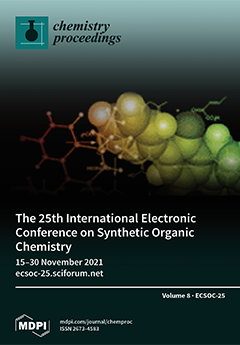Currently, mitochondria are considered as an attractive universal target in the development of new anticancer drugs. These organelles are essential in energy production, the regulation of cell death pathways, the generation of reactive oxygen species, as well as in the maintenance of calcium
[...] Read more.
Currently, mitochondria are considered as an attractive universal target in the development of new anticancer drugs. These organelles are essential in energy production, the regulation of cell death pathways, the generation of reactive oxygen species, as well as in the maintenance of calcium homeostasis. Various approaches are being developed to deliver biologically active compounds into the mitochondria of tumour cells, including the conjugation of cytotoxic substances with mitochondria-targeted lipophilic cations. Among the currently known low molecular weight lipophilic cationic molecules, (
E)-4(1
H-indol-3-ylvinyl)-
N-methylpyridinium iodide (
F16) is of great interest. This mitochondria-toxic cationic compound with luminescent properties is selectively accumulated in mitochondria and can selectively trigger the apoptosis and necrosis of tumour cells, making it an attractive targeted agent for theranostic use. Meanwhile, betulinic acid, an available natural pentacyclic triterpenoid, has been considered as a promising scaffold for the development of new anticancer agents in recent years. The antitumour effect of this natural product arises from it affecting the mitochondria of tumour cells through the formation of reactive oxygen species. The present article details of an efficient synthesis of a novel multifunctional hybrid agent in which a cytotoxic triterpenoid, betulinic acid, is carbon-carbon bonded to the cationic
F16 fragment at the C-2 position of ring A through a phenylethynyl spacer. The starting substrates in the synthesis were the C-2 propynyl derivative of betulinic acid and
N-aryl-substituted 4-(1
H-indol-3-ylvinyl)-pyridine. The derivative of betulinic acid with a terminal acetylenic group was prepared by the reaction of C-alkylation with propargyl bromide of potassium enoxytriethylborate generated from betulonic acid. To obtain the
N-aryl-substituted analogue of
F16, a CuI-catalyzed Ullmann-Goldberg reaction was applied. The synthesis of the target conjugate was successfully completed by the cross-coupling of the terpene and heterocyclic components according to Sonogashira in the presence of the CuI/Pd(PPh
3)
2 catalyst.
Full article



